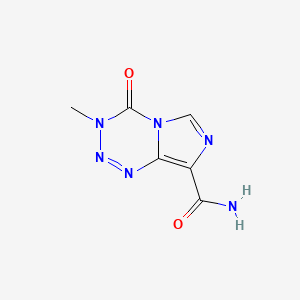Glioblastoma multiforme
Adult: In newly diagnosed patients: Concomitant phase: 75 mg/m2 via infusion over 90 minutes once daily for 42 days, with focal radiotherapy. Dosing interruption or discontinuation may be required during the concomitant phase based on toxicity (refer to product guideline). Maintenance phase (starting 4 weeks after completion of concomitant phase): Cycle 1: 150 mg/m2 once daily on Days 1-5 of a 28-day cycle. Cycles 2-6: May increase to 200 mg/m2 once daily on Days 1-5 of each 28-day cycle; if the dose was not escalated at the onset of Cycle 2, do not increase the dose in succeeding cycles. Dose reduction, interruption or discontinuation may be required during the maintenance phase according to individual safety or tolerability (refer to detailed product guideline).
Intravenous
Refractory anaplastic astrocytoma
Adult: In patients who have experienced disease progression on a drug regimen containing nitrosourea and procarbazine: 150 mg/m2 via infusion over 90 minutes once daily on Days 1-5 of a 28-day cycle; dose for succeeding cycles may be increased to 200 mg/m2 once daily on Days 1-5 of a 28-day cycle if there is no toxicity. Continue until disease progression or unacceptable toxicity. Dose modifications may be needed according to individual safety or tolerability (refer to detailed product guideline).
Oral
Anaplastic astrocytoma, Recurrent glioblastoma multiforme
Adult: Patients who are not previously treated with chemotherapy: 200 mg/m2 once daily for Days 1-5 of a 28-day cycle. Patients previously treated with chemotherapy: 150 mg/m2 once daily on Days 1-5 of a 28-day cycle; dose for succeeding cycles may be increased to 200 mg/m2 daily on Days 1-5 of a 28-day cycle if there is no toxicity. Continue until disease progression or unacceptable toxicity. Dose modifications may be needed according to individual safety or tolerability (refer to detailed product guideline).
Child: ≥3 years Same as adult dose. Dosage recommendations may vary among countries or individual products. Refer to specific product guidelines.
Child: ≥3 years Same as adult dose. Dosage recommendations may vary among countries or individual products. Refer to specific product guidelines.
Oral
Metastatic malignant melanoma
Adult: 200 mg/m2 once daily on Days 1-5 of a 28-day cycle.
Oral
Glioblastoma multiforme
Adult: In newly diagnosed patients: Concomitant phase: 75 mg/m2 once daily for 42 days, with focal radiotherapy. Dosing interruption or discontinuation may be required during the concomitant phase based on toxicity. Maintenance phase (starting 4 weeks after completion of concomitant phase): Cycle 1: 150 mg/m2 once daily on Days 1-5 of a 28-day cycle. Cycles 2-6: May increase to 200 mg/m2 once daily on Days 1-5 of a 28-day cycle; if the dose was not escalated at the onset of Cycle 2, do not increase the dose in succeeding cycles. Dose reduction, interruption or discontinuation may be required during the maintenance phase according to individual safety or tolerability (refer to detailed product guideline).




 Sign Out
Sign Out




